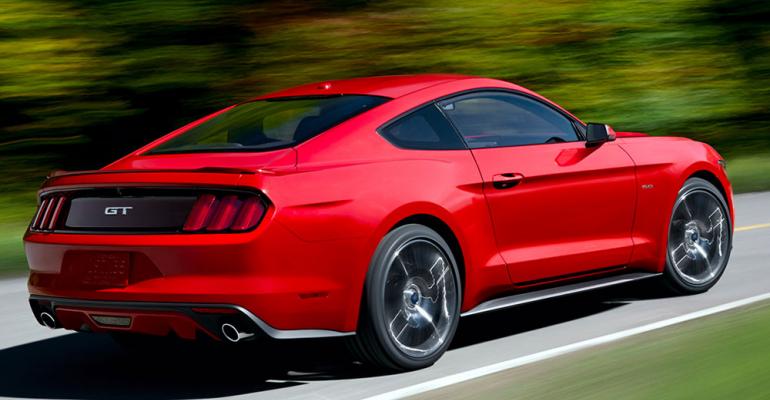DEARBORN, MI – Power ratings for the three engines powering the sixth-generation ’15 Mustang have been circulating for months, but Ford adds to the list with power-density numbers that it says harness top performance to maximum efficiency.
A new 2.3L inline 4-cyl. EcoBoost engine, the first turbocharged Mustang mill since the 2.3L 4-cyl. in the limited-edition ’84-’86 SVO, joins a naturally aspirated 3.7L V-6 and 5.0L V-8 in the pony car’s powertrain lineup.
‟We knew we had to beat every other Mustang we’d ever done,” Raj Nair, group vice president-Global Product Development, tells media at the Ford test track here. ‟This is a great, dynamic-attitude car we’re really proud of.”
The benchmark chosen by the engineering team was the ’69-’70 Boss 302 powered by a small-block V-8 making 290 hp and 290 lb.-ft. (393 Nm) of torque, with consideration also given to the BMW M3 and Porsche 911.
Power numbers in the carryover 5.0L have been bumped up to an unofficial 435 hp and 400 lb.-ft. (542 Nm) thanks to tweaks including larger intake and exhaust valves and a rebalanced, forged camshaft to handle higher RPMs. The 3.7L V-6 delivers 300 hp and 280 lb.-ft. (380 Nm) of torque.
For the 2.3L 4-cyl., EcoBoost powertrain engineering manager Scott Makowski says, ‟I wanted both numbers to start with a three.” A twin-scroll turbocharger teamed with twin independent variable camshaft timing and direct fuel injection helps the compact powerplant hit those targets by turning out 310 hp and 320 lb.-ft. (427 Nm) of torque, also unofficial.
Ford kept the new Mustang’s weight under control using technologies such as hydroforming and laser welding, and materials including high-strength steels and aluminum for the hood and front fenders. This helped offset the added weight of the independent rear suspension and added content including bigger brakes and double the number of airbags, Nair says.
The result is an EcoBoost fastback with automatic transmission weighing 3,524 lbs. (1,596 kg), just 6 lbs. (2.7 kg) heavier than the lightest ’14 Mustang V-6, and yielding a power-to-weight ratio of 11.37 lbs./hp. The GT fastback with manual transmission picks up 87 lbs. (39.4 kg) but achieves a ratio of 8.52 lbs./hp.
Fuel-economy figures and pricing will be released closer to launch in the U.S. this fall. The ’15 Mustang rolls out in the first half of next year in Europe, and in Asia-Pacific in the second half.
Ford will offer only the 4-cyl. and 8-cyl. outside North America as it makes its first sustained push to sell the Mustang overseas. Nair declines to estimate the sales mix of the two mills. ‟The customer decides.”





